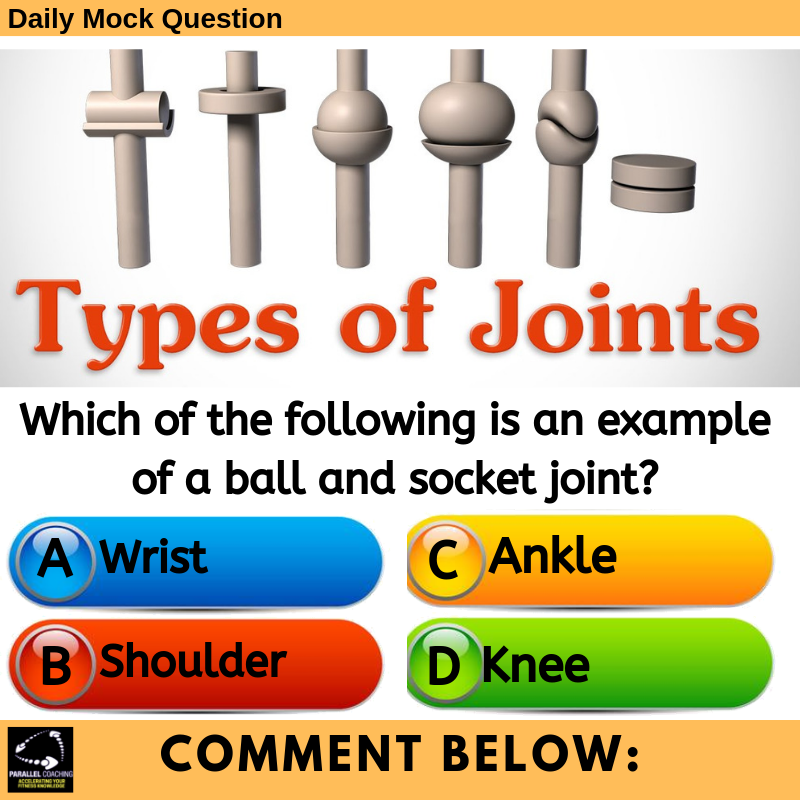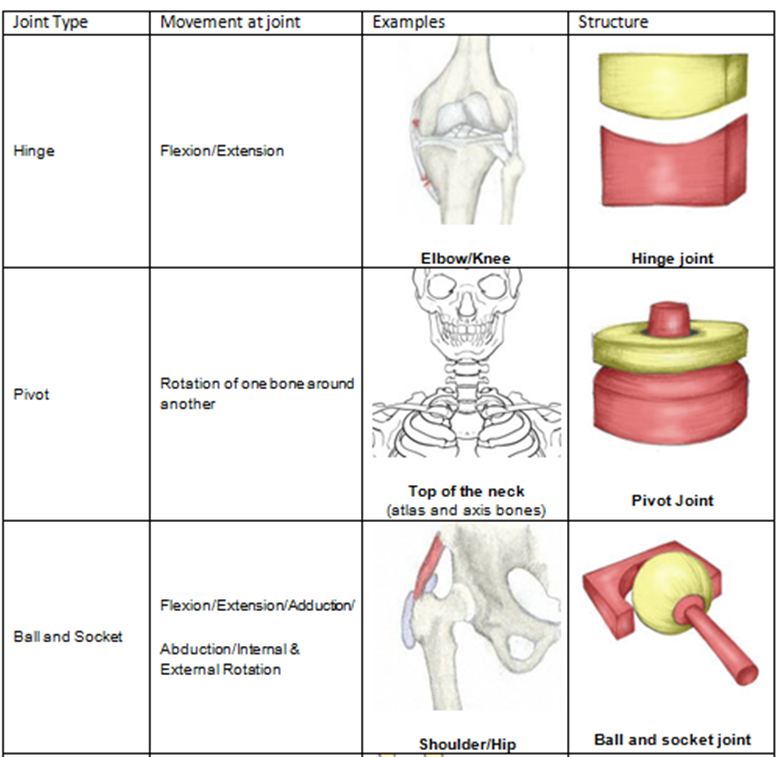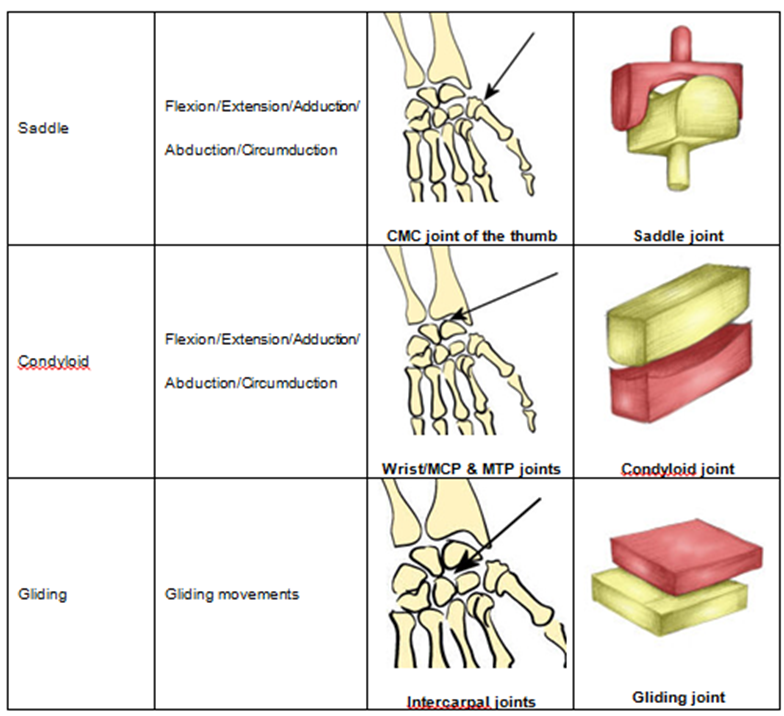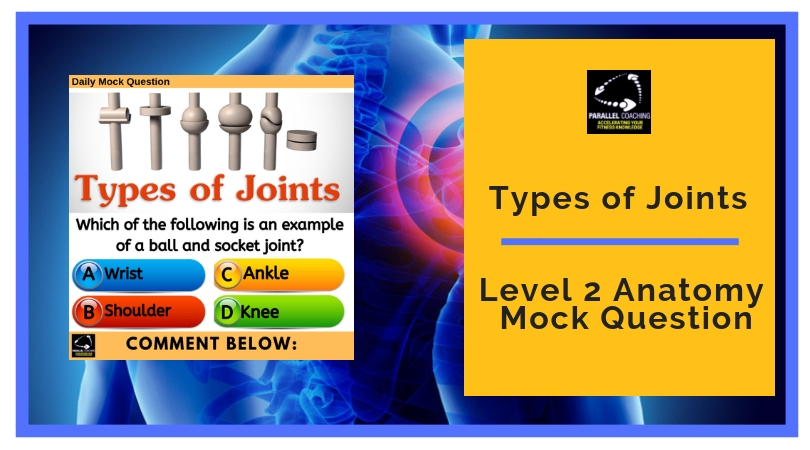As part of the Level 2 Anatomy and Physiology exam, you need to know the 6 Types of joints in our body.
Today’s blog starts with a mock question typical of what you’ll see in your exam, so you can test your knowledge first.
Then you’ll learn all 6 types of joints, and an easy way o remember them in preparation for your exam
🧐 Level 2 + 3 Anatomy & Physiology Mock Question
Q: Which of the following is an example of a ball and socket joint❓
- A. Wrist
- B. Shoulder
- C. Ankle
- D. Knee

The Correct Answer is B = Shoulder
Find out why, by reading the rest of the blog below…
What is a Joint?
A Joint is a structure in the human body at which two parts of the skeleton meet. Most joints allow for movement (however there is one type that is fixed and allows no movement).
All movement, whether it is flexion, extension, rotation or supination, occurs at a joint.
Let’s look at the Knee for example:
If we want to flex the knee (bring the heel towards the bum), our hamstrings have to contract concentrically (get shorter).
The hamstring crosses the back of the knee, so as it shortens it will pull the two attachment points of the muscle closer together.
This is movement, and it is only made possible by the joints in or body
What are the 3 Types of Joints?
There are three global types of joints, each with a different purpose and different characteristics.
Fused/Fibrous:
These joints exist primarily to assist in childbirth, for example, the joints of the skull are soft at birth, so the skull can be smaller (OUCH!), but then as the child grows, and the brain develops the joints of the skull fuse. This allows them to be fixed and stable with no articulation or movement.
Cartilaginous:
These are partially moveable joints which means that they move more than Fused/ Fibrous joints but less than synovial joints. They are usually in areas of the body that require a little bit of movement but a lot of stability in order to protect the vital organs. For example in between the ribs and sternum, or in between the vertebrae.
Synovial:
These are the most common Joints in the body and they are fully moveable. A synovial joint has a synovial capsule between the two articulating bones which means allows for smoother movement at the joint, as well as reduced impact. We have 6 types of synovial joints
The Mock Question above lists 4 joints that are all synovial (wrist, shoulder, ankle, and knee), however each joint acts in a different way and allows for different movements.
If you want more mock questions like this, then you can download more Free Mock Questions: DOWNLOAD NOW

What are the 6 Types of Joints?
There are 6 types of synovial joints which are classified by the shape of the joint and the movement available. This table shows all 6 types of freely moveable (synovial joints in the body)


How to remember the 6 types of joints:
You can use this mnemonic to help remember all 6:
Synovial Connections Pained Her Brain Guaranteed:
S = Synovial = Saddle
C = Connections = Condyloid
P = Pained = Pivot
H = Her = Hinge
B = Brain = Ball and Socket
G = Guaranteed = Gliding
Why do I need to know the types of joints?
Firstly, it is likely that you will get 3-5 questions relating to joints in your Level 2 anatomy and physiology exam. This knowledge is then “assumed” when you get to Level 3, so it is important to know the basics now.
Secondly, it is important after your exam…
Knowing how the body moves:
As a fitness instructor, Personal trainer, pilates teacher or coach, your prime role is to educate your clients about how to move safely and effectively. As movement all comes from the joints, knowing about the types of joints is the foundation of you being a great movement coach.
Knowing how a synovial joint can (and cannot) move is crucial for safe movement.
This knowledge will also help you to understand musculoskeletal conditions like Osteoarthritis and Joint Replacements if you decide to work with Long term Conditions as a Specialist in the future.
In summary
- Joints allow for all of our movement
- There are 3 global types of joints, each with different characteristics
- There are 6 types of synovial joints, each allowing movement in a different way
Need More Help with your Level 2 Anatomy Revision?
For Trainee FITPROS Taking Their L2 Anatomy & Physiology Exam.
Learn, Revise & Pass Your Level 2 Anatomy & Physiology Exam In Under 10 hours
(Without Having To Spend Hours Revising Or Feeling Overwhelmed)
If you want to get your revision structured, learn everything you need to know, and feel confident on exam day, then click the link below:

Dedicated to More
Hayley “Types of Joints” Bergman
Parallel Coaching
P.S. You can also find us on the following platforms:
Instagram: Follow Now
Facebook: Like Our Page
Twitter: Tweet Us
YouTube: Subscribe Here
More Skeletal System Blogs: HERE

